Effects of a New Type of Shrinkage-Reducing Agent on Concrete Properties
Abstract
:1. Introduction
2. Experimental
2.1. Materials
2.2. Casting and Testing of Concrete
2.3. Measurement of Hardened Concrete Properties
2.4. Cement Hydration
3. Results
3.1. Surface Tension of SRA
3.2. Concrete Properties
3.3. Concrete Shrinkage
3.4. Resistance to Freezing and Thawing Action
4. Discussion
5. Conclusions
Author Contributions
Funding
Conflicts of Interest
References
- Goto, T.; Sato, T.; Sakai, K.; Ii, M. Cement-Shrinkage-Reducing Agent and Cement Composition. U.S. Patent 4,547,223, 15 October 1985. United States Patent and Trademark Office. [Google Scholar]
- Folliard, K.J.; Berke, N.S. Properties of high- performance concrete containing shrinkage-reducing admixture. Cem. Concr. Res. 1997, 9, 1357–1364. [Google Scholar] [CrossRef]
- Rongbing, B.; Jian, S. Synthesis and evaluation of shrinkage-reducing admixture for cementitious materials. Cem. Concr. Res. 2005, 35, 445–448. [Google Scholar] [CrossRef]
- Balogh, A. New admixture combats concrete shrinkage. Concr. Constr. 1996, 41, 546–551. [Google Scholar]
- Rajabipour, F.; Sant, G.; Weiss, J. Interactions between shrinkage reducing admixtures (SRA) and cement paste’s pore solution. Cem. Concr. Res. 2008, 38, 606–615. [Google Scholar] [CrossRef]
- Roncero, J.; Gettu, R.; Martín, M.A. Evaluation of the Influence of a Shrinkage Reducing Admixture on the Microstructure and Long-Term Behavior of Concrete. In Proceedings of the 7th CANMET/ACI International Conference on Superplasticizers and Other Chemical Admixtures in Concrete (Supplementary Papers), Berlin, Germany, 20–23 October 2003; pp. 207–226. [Google Scholar]
- Ribeiro, A.B.; Carrajola, A.; Gonçalves, A. Behavior of Mortars with Different Dosages of Shrinkage Reducing Admixtures. In Proceedings of the 8th CANMET/ ACI International Conference on Superplasticizers and Other Chemical Admixtures in Concrete (SP-239), Sorrento, Italy, 29 October–1 November 2006; American Concrete Institute: Farmington Hill, MI, USA; pp. 77–91. [Google Scholar]
- Borsoi, A.; Collepardi, M.; Collepardi, S.; Troli, R. Influence of chemical admixtures on the drying shrinkage of concrete. In Proceedings of the 9th CANMET/ ACI International Conference on Superplasticizers and Other Chemical Admixtures in Concrete (Supplementary Papers), Seville, Spain, 21–24 October 2009; pp. 1–9. [Google Scholar]
- Maruyama, I.; Beppu, K.; Kurihara, R.; Furuta, A. Action mechanisms of shrinkage reducing admixtures in hardened cement paste. J. Adv. Concr. Technol. 2016, 14, 311–323. [Google Scholar] [CrossRef] [Green Version]
- Park, J.J.; Kim, S.; Shin, W.; Choi, H.J.; Park, G.J.; Yoo, D.Y. High performance photocatalytic cementitious materials containing synthetic fibers and shrinkage-reducing admixture. Materials 2020, 13, 1828. [Google Scholar] [CrossRef] [Green Version]
- Ran, Q.; Gao, N.; Liu, J.; Tian, Q.; Zhang, J. Shrinkage action mechanism of shrinkage-reducing admixture based on the pore solution. Mag. Concr. Res. 2013, 65, 1092–1100. [Google Scholar] [CrossRef]
- Yoo, D.Y.; Ryu, G.S.; Yuan, T.; Koh, K.T. Mitigating shrinkage cracking in posttensioning grout using shrinkage-reducing admixture. Cem. Concr Compos. 2017, 81, 97–108. [Google Scholar] [CrossRef]
- Bílek, V., Jr.; Kalina, L.; Novotný, R.; Tkacz, J.; Paříze, L.K. Some issues of shrinkage-reducing admixtures application in alkali-activated slag system. Materials 2016, 9, 462. [Google Scholar]
- Corinaldesi, V. Combined effect of expansive, shrinkage reducing and hydrophobic admixtures for durable self compacting concrete. Constr. Build. Mater. 2012, 36, 758–764. [Google Scholar] [CrossRef]
- Bentz, D.P. Influence of shrinkage-reducing admixtures on early-age properties of cement paste. J. Adv. Concr. Technol. 2006, 4, 423–429. [Google Scholar] [CrossRef] [Green Version]
- Qin, R.; Hao, H.; Rousakis, T.; Lau, D. Effect of shrinkage reducing admixture on new-to-old concrete interface. Compos. Part. B 2019, 167, 346–355. [Google Scholar] [CrossRef]
- Mora-Ruacho, J.; Gettu, R.; Aguado, A. Influence of shrinkage-reducing admixtures on the reduction of plastic shrinkage cracking in concrete. Cem. Concr. Res. 2009, 39, 141–146. [Google Scholar] [CrossRef]
- Brooks, J.J.; Johari, M.A.M.; Mazloom, M. Effect of admixtures on the setting times of high-strength concrete. Cem. Concr. Compos. 2000, 22, 293–301. [Google Scholar] [CrossRef]
- Berke, N.S.; Li, L.; Hicks, M.C.; Bae, J. Improving Concrete Performance with Shrinkage-Reducing Admixtures. In Proceedings of the 7th CANMET/ ACI International Conference on Superplasticizers and Other Chemical Admixtures in Concrete (SP-217), Berlin,Germany, 20–23 October 2003; American Concrete Institute: Farmington Hill, MI, USA; pp. 37–50. [Google Scholar]
- Zuo, W.Q.; Feng, P.; Zhong, P.; Tian, Q.; Gao, N.; Wang, Y.; Yu, C.; Miao, C. Effects of novel polymer-type shrinkage-reducing admixture on early age autogenous deformation of cement pastes. Cem. Concr. Res. 2017, 100, 413–422. [Google Scholar] [CrossRef]
- Magua, D.D. Evaluation of the Air Void Analyzer. Concr. Int. 1996, 18, 55–59. [Google Scholar]
- Yogarajah, E.; Natsumi, N.; Kazuki, M.; Yuka, M.; Takashi, C.; Hiroyoshi, K.; Toyoharu, N. Characteristics of ferrite-rich Portland cement: Comparison with ordinary Portland cement. Front.Mater. 2019, 6, 97. [Google Scholar]
- Griffin, W.C. Classification of surface active agents by HLB. J. Soc. Cosmet. Chem. 1949, 1, 311–326. [Google Scholar]
- Mindess, S.; Young, J.F.; Darwin, D. Concrete, 2nd ed.; Prentice Hall: Upper Saddle River, NJ, USA, 2003. [Google Scholar]
- Jennings, H.M. Refinements to colloid model of C-S-H in cement:CM-II. Cem. Concr. Res. 2008, 38, 275–289. [Google Scholar] [CrossRef]
- Jennings, H.M. Colloid model of C-S-H and implications to the problem of creep and shrinkage. Mater. Struct. 2004, 37, 59–70. [Google Scholar] [CrossRef]
- Hauet, T.; Eugene, M.A. New approach in organ preservation: Potential role of new polymer. Kidney Int. 2008, 74, 998–1003. [Google Scholar] [CrossRef] [PubMed] [Green Version]
- Shikata, T.; Okuzono, M.; Sugimoto, N. Temperature-dependent hydration/dehydration behavior of poly(ethylene oxide)s in aqueous solution. Macromolecules 2013, 46, 1956–1961. [Google Scholar] [CrossRef]
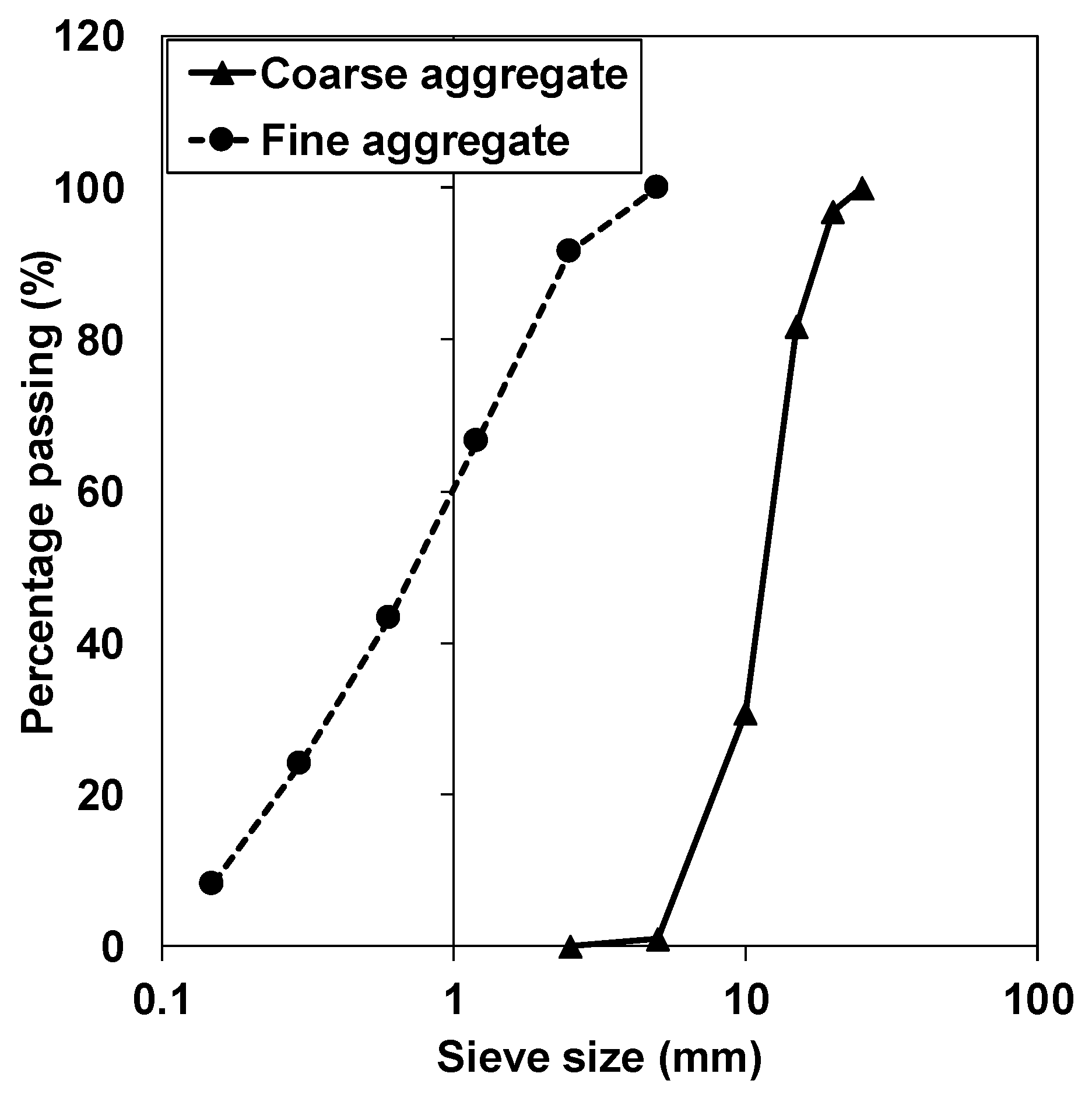

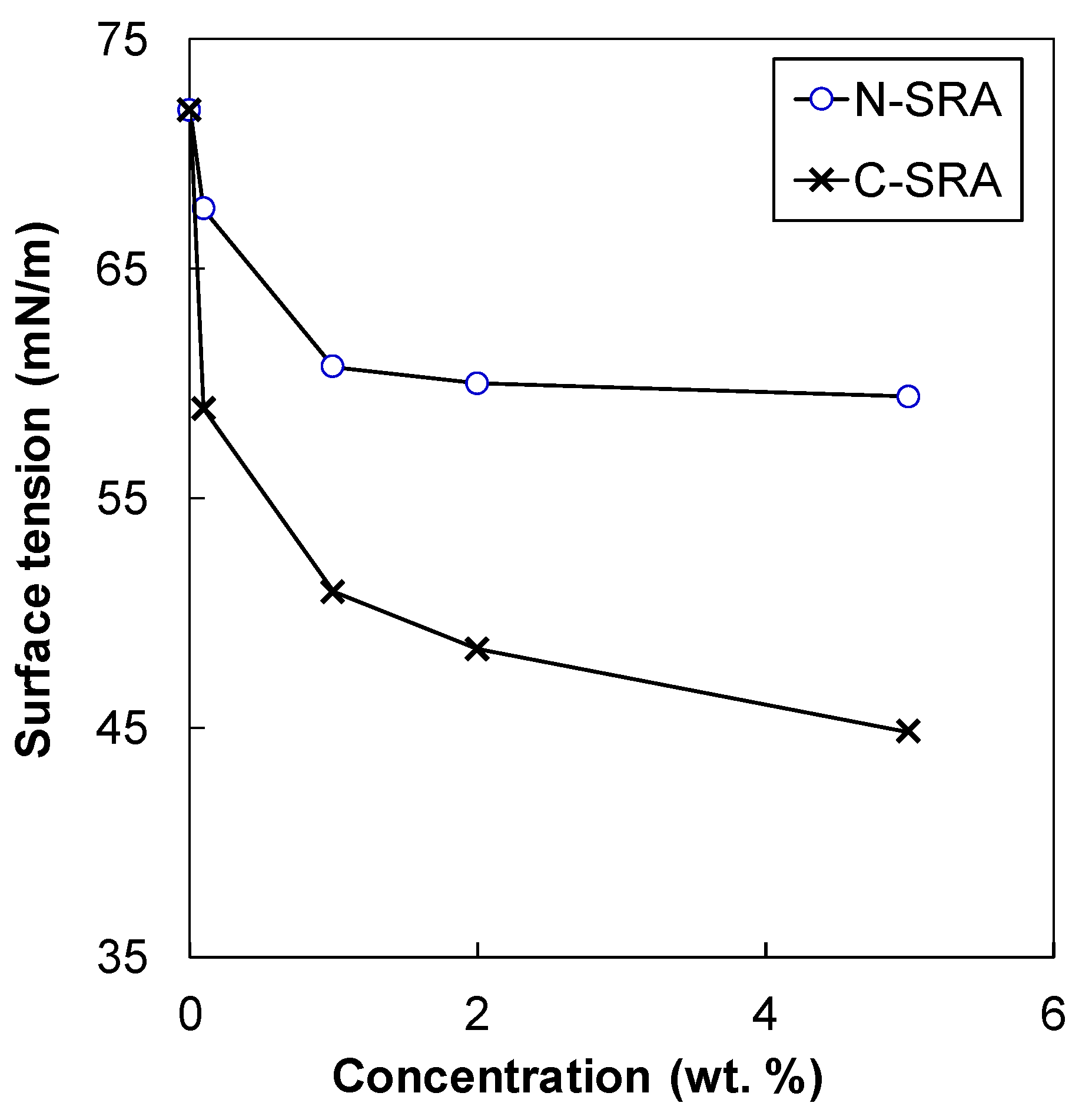
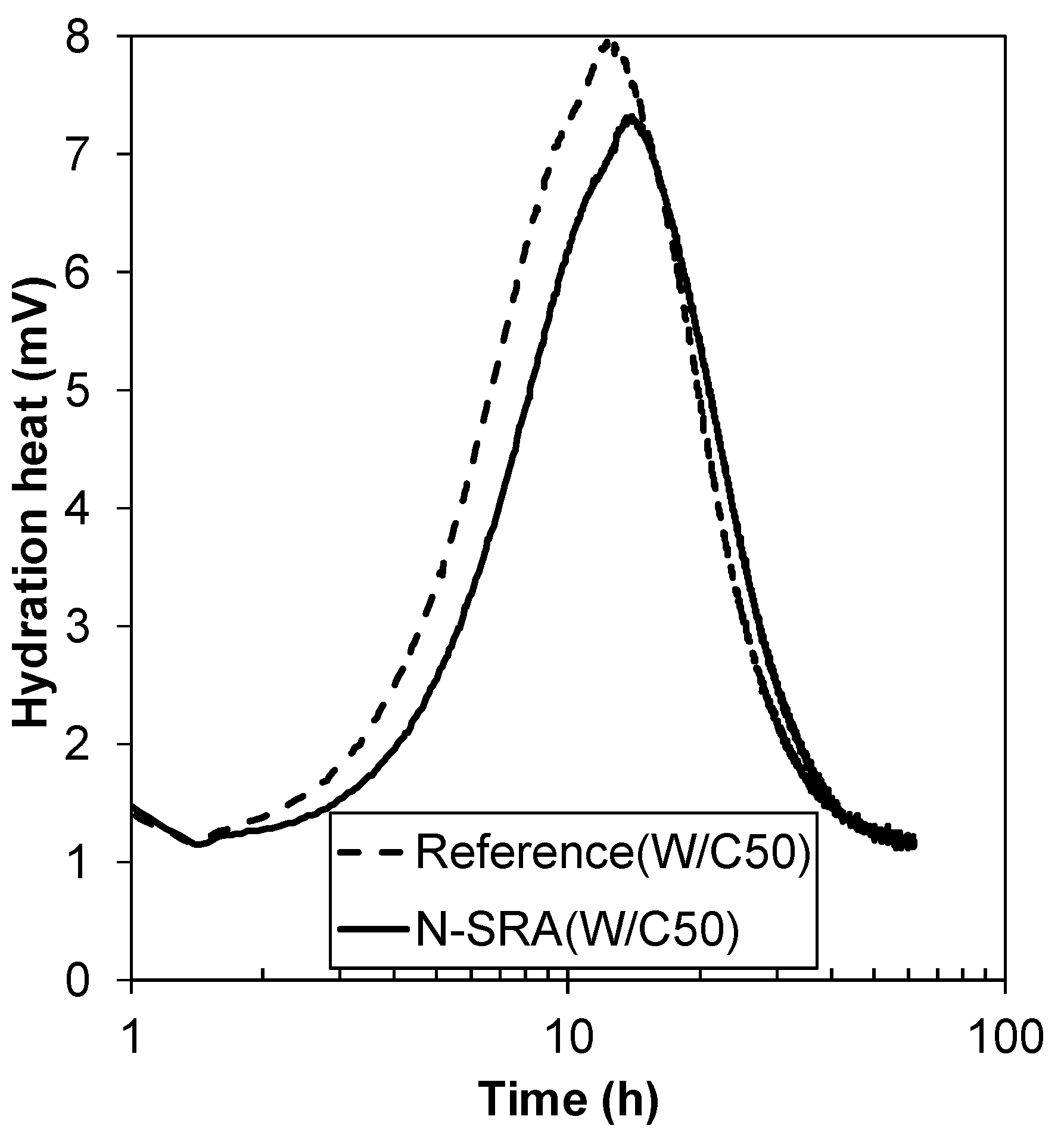
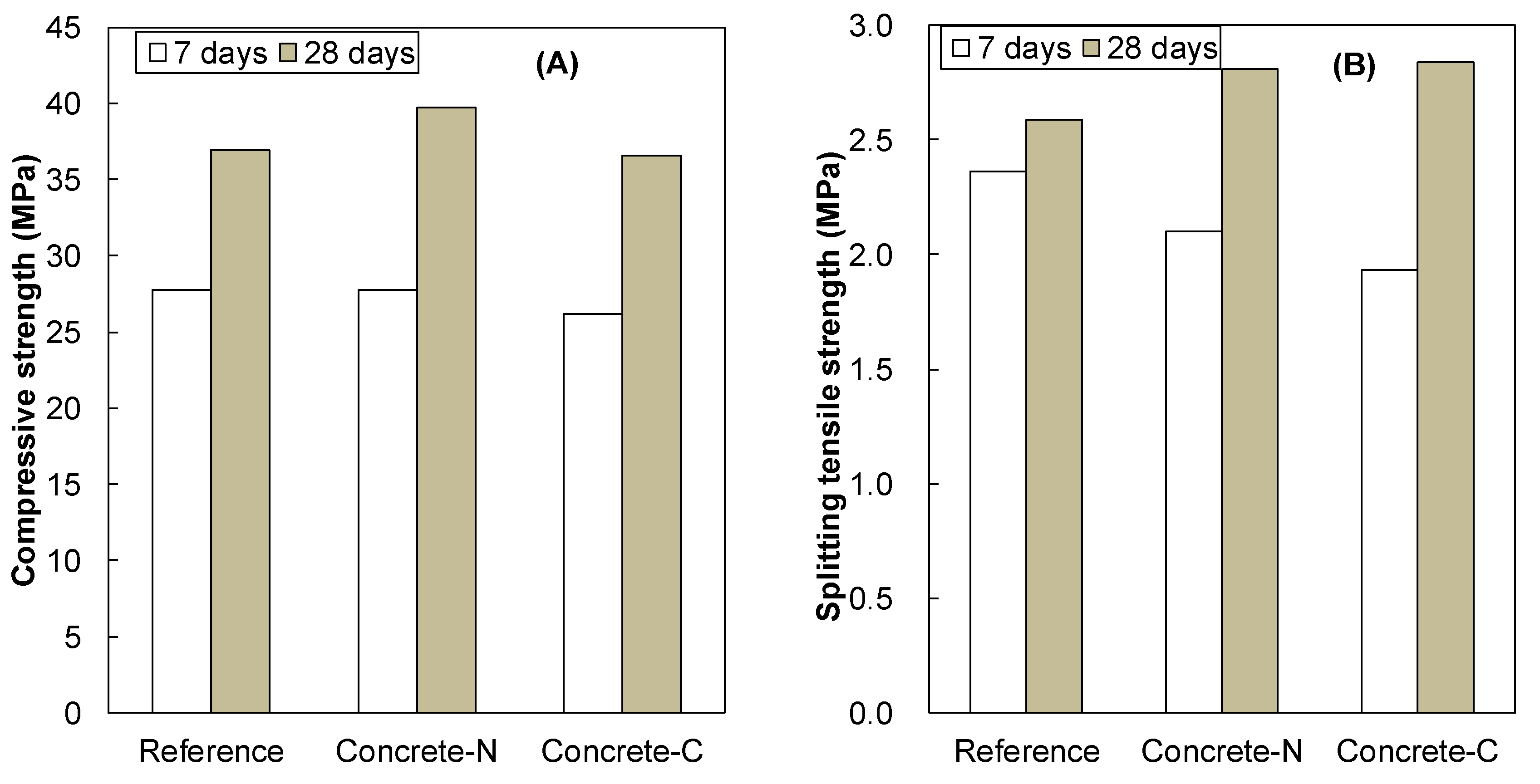
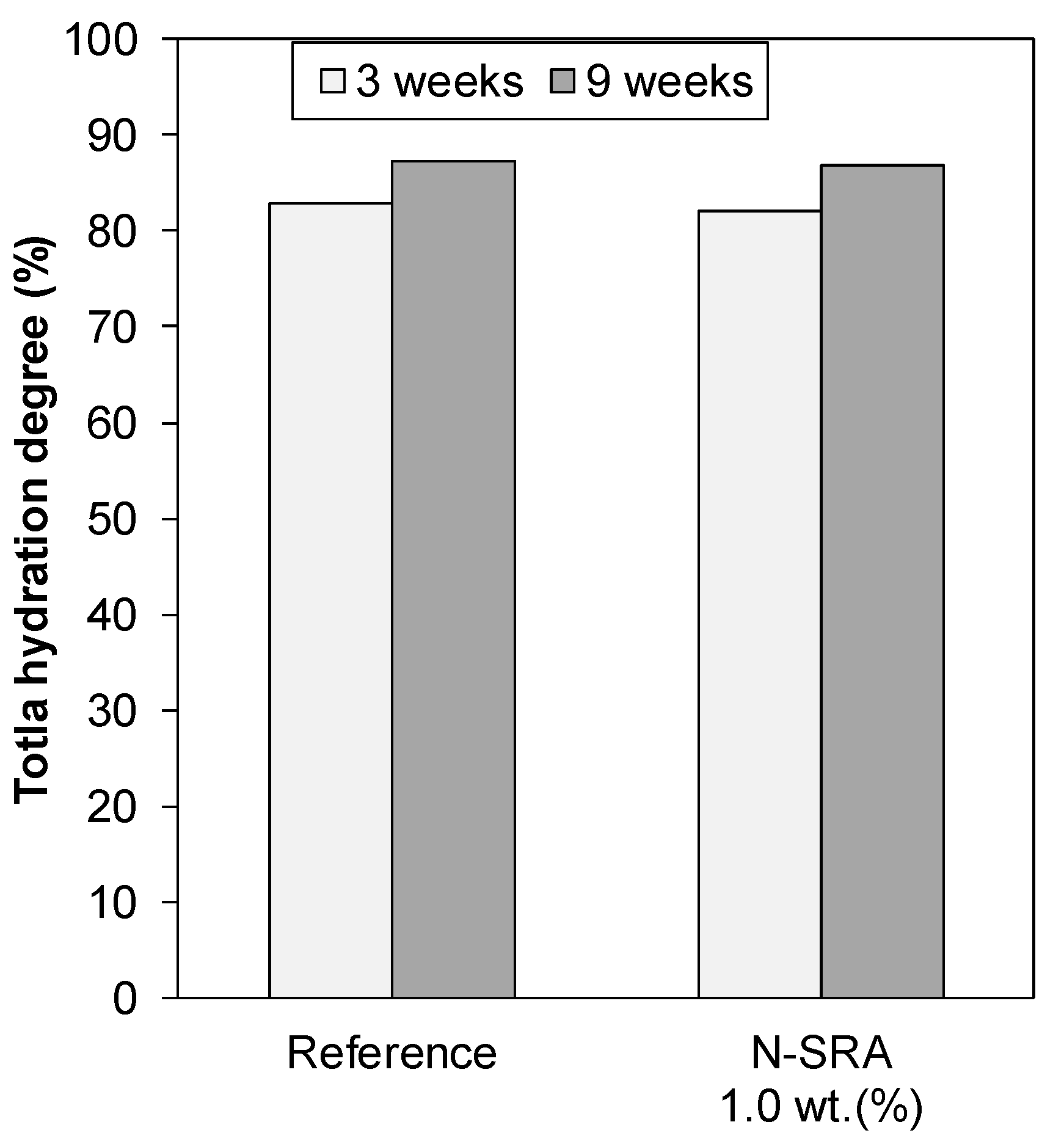

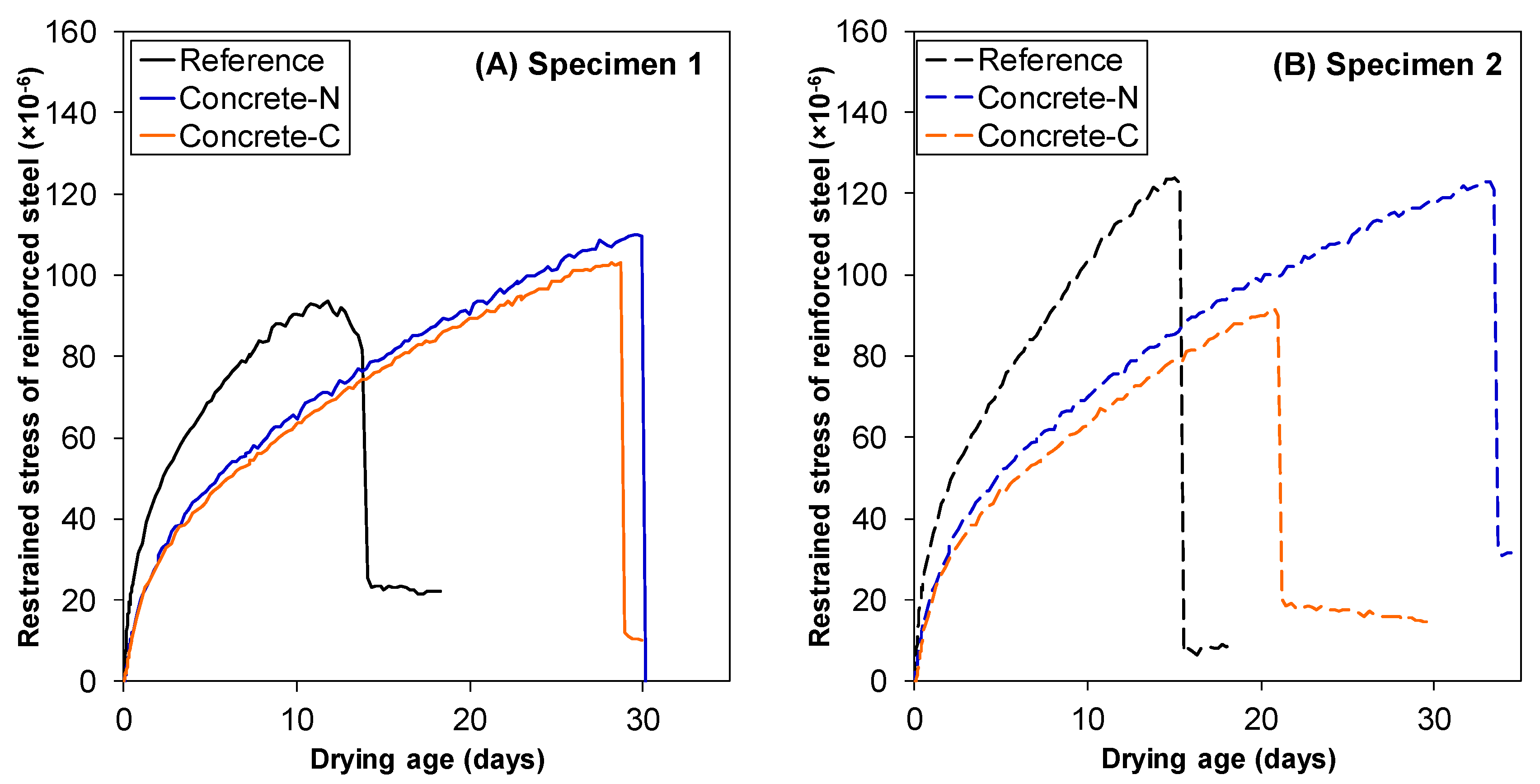
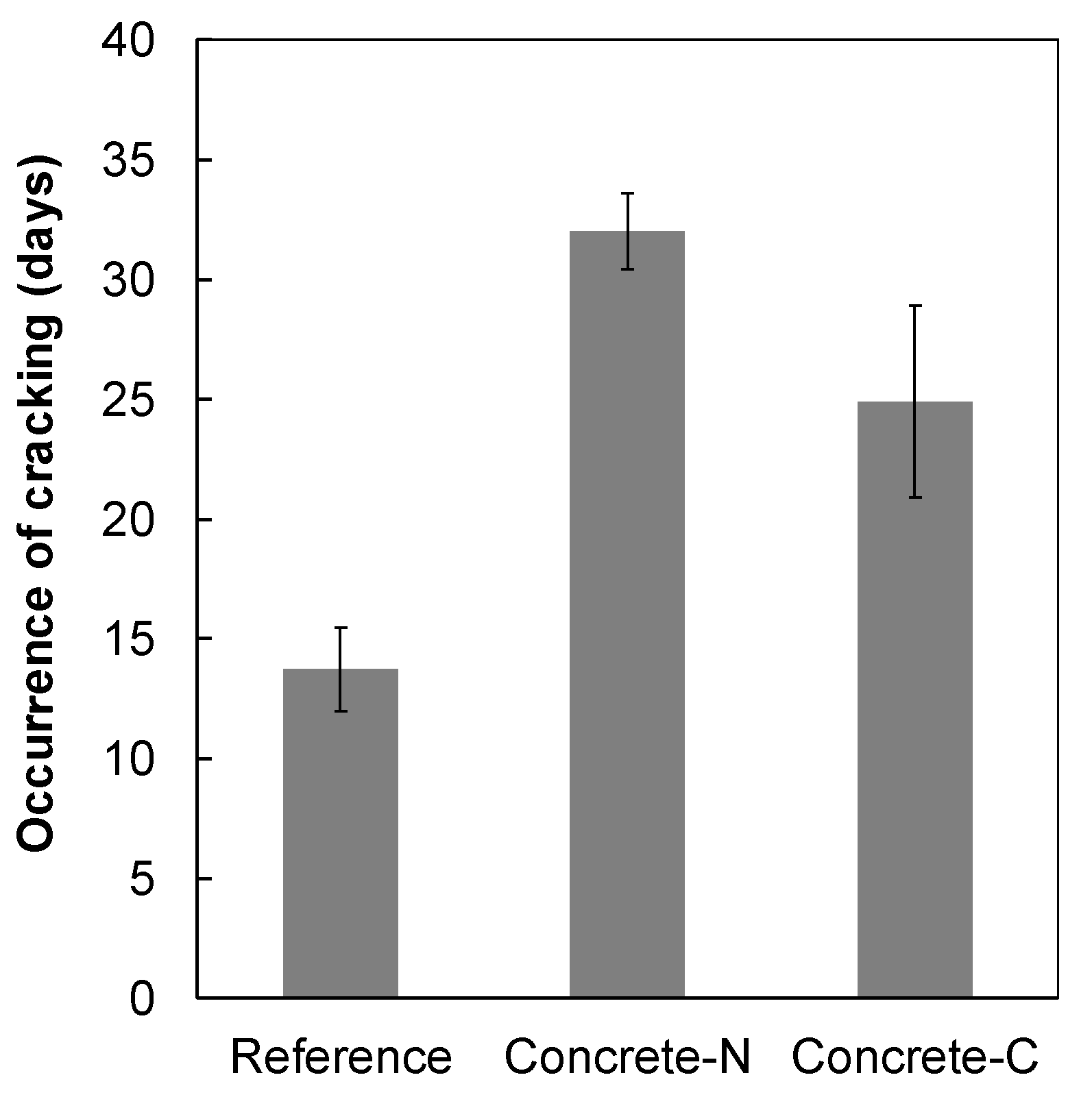
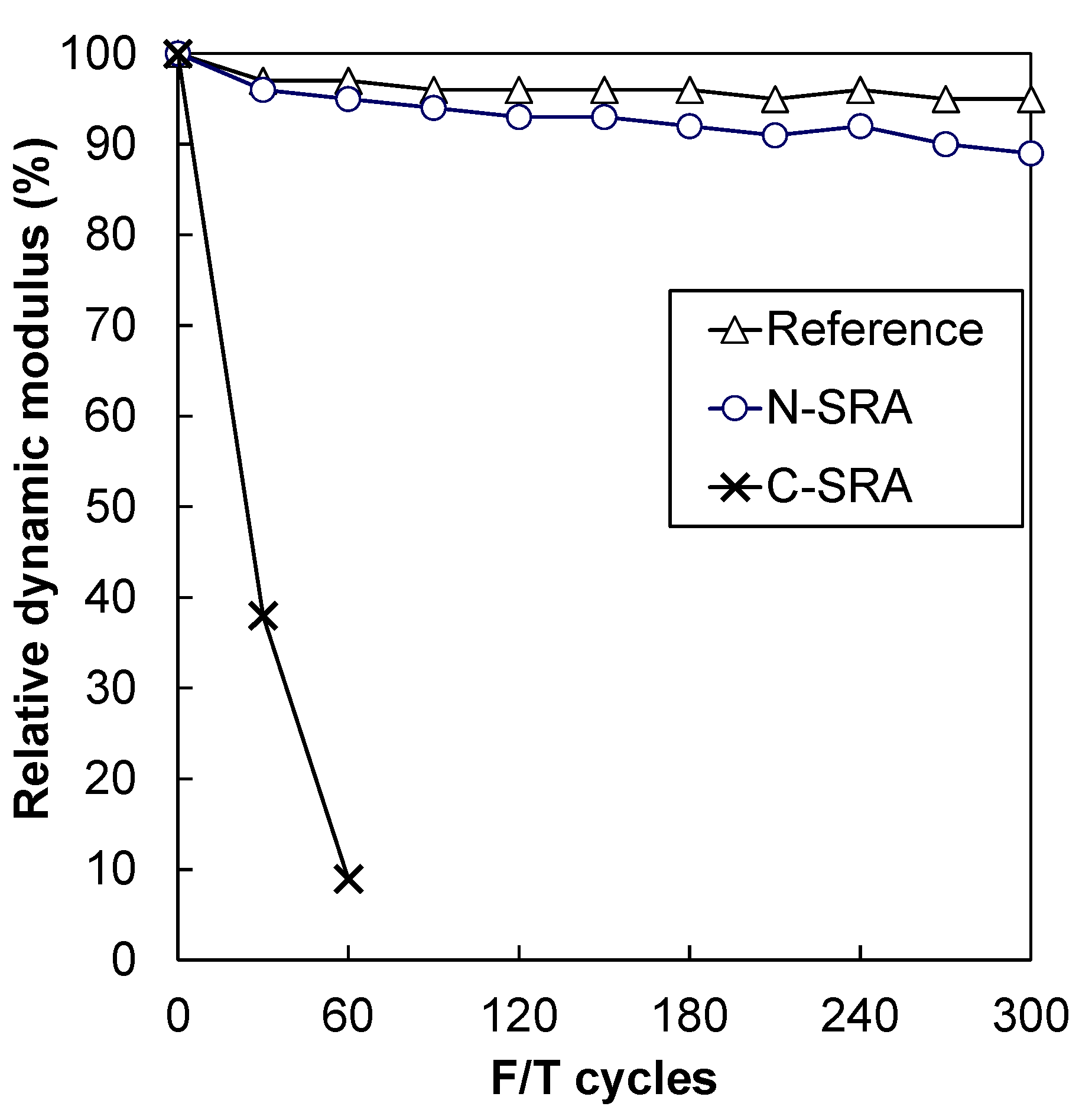
| Mineral Composition | (%) |
|---|---|
| C3S | 56 |
| C2S | 18 |
| C3A | 9 |
| C4AF | 9 |
| Loss on ignition | 1.91 |
| Specific surface area | 3300 cm2/g |
| Density | 3.16 g/cm3 |
| Reference | Concrete-N | Concrete-C | |
|---|---|---|---|
| Coarse aggregate (kg/m3) | 939 | 939 | 939 |
| Fine aggregate (kg/m3) | 853 | 853 | 853 |
| Cement (kg/m3) | 309 | 309 | 309 |
| Water (kg/m3) | 170 | 170 | 170 |
| Superplasticizer (% BWOC) | 0.80 | 0.30 | 0.80 |
| N-SRA (% BWOC) | 0 | 1.0 | 0 |
| C-SRA (% BWOC) | 0 | 0 | 2.0 |
| w/c | 0.55 | 0.55 | 0.55 |
| Slump (cm) | 19.0 | 18.5 | 19.0 |
| Slump flow (cm) | 290 | 285 | 295 |
| Air (%) | 5.5 | 5.4 | 4.9 |
| Spacing factor (μm) | 316 | 283 | 439 |
| Setting time: Initial (h) | 6:00 | 6:45 | 6:40 |
| Final (h) | 8:15 | 9:15 | 9:15 |
| Concrete Mix | SRA | Spacing Factor (μm) | Specific Surface Area (mm2/mm3) |
|---|---|---|---|
| Concrete-N | N-SRA | 283 | 16.8 |
| Concrete-C | C-SRA | 439 | 13.9 |
| Reference | - | 316 | 15.6 |
© 2020 by the authors. Licensee MDPI, Basel, Switzerland. This article is an open access article distributed under the terms and conditions of the Creative Commons Attribution (CC BY) license (http://creativecommons.org/licenses/by/4.0/).
Share and Cite
Masanaga, M.; Hirata, T.; Kawakami, H.; Morinaga, Y.; Nawa, T.; Elakneswaran, Y. Effects of a New Type of Shrinkage-Reducing Agent on Concrete Properties. Materials 2020, 13, 3018. https://doi.org/10.3390/ma13133018
Masanaga M, Hirata T, Kawakami H, Morinaga Y, Nawa T, Elakneswaran Y. Effects of a New Type of Shrinkage-Reducing Agent on Concrete Properties. Materials. 2020; 13(13):3018. https://doi.org/10.3390/ma13133018
Chicago/Turabian StyleMasanaga, Mari, Tsuyoshi Hirata, Hirokatsu Kawakami, Yuka Morinaga, Toyoharu Nawa, and Yogarajah Elakneswaran. 2020. "Effects of a New Type of Shrinkage-Reducing Agent on Concrete Properties" Materials 13, no. 13: 3018. https://doi.org/10.3390/ma13133018
APA StyleMasanaga, M., Hirata, T., Kawakami, H., Morinaga, Y., Nawa, T., & Elakneswaran, Y. (2020). Effects of a New Type of Shrinkage-Reducing Agent on Concrete Properties. Materials, 13(13), 3018. https://doi.org/10.3390/ma13133018





